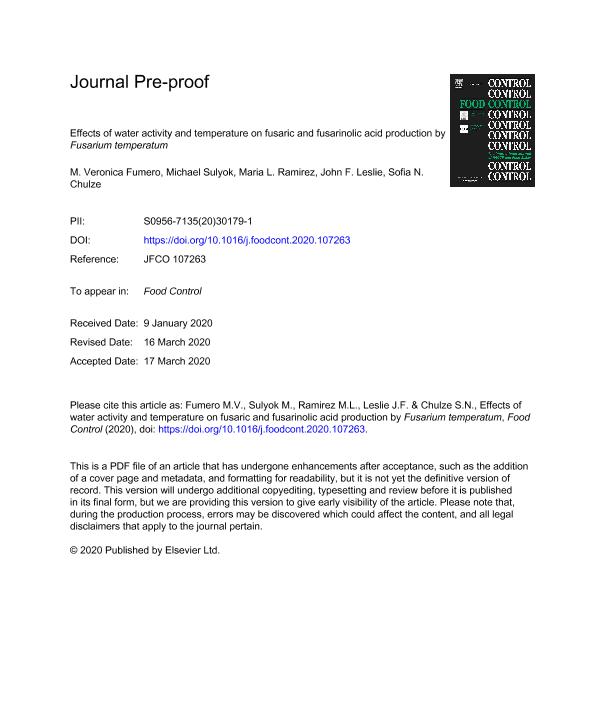Mostrar el registro sencillo del ítem
dc.contributor.author
Fumero, María Verónica

dc.contributor.author
Sulyok, Michael
dc.contributor.author
Ramirez, Maria Laura

dc.contributor.author
Leslie, John

dc.contributor.author
Chulze, Sofia Noemi

dc.date.available
2021-03-10T14:54:49Z
dc.date.issued
2020-08-20
dc.identifier.citation
Fumero, María Verónica; Sulyok, Michael; Ramirez, Maria Laura; Leslie, John; Chulze, Sofia Noemi; Effects of water activity and temperature on fusaric and fusarinolic acid production by Fusarium temperatum; Elsevier; Food Control; 114; 107263; 20-8-2020; 107-263
dc.identifier.issn
0956-7135
dc.identifier.uri
http://hdl.handle.net/11336/127956
dc.description.abstract
Fusaric acid (FA) is a secondary metabolite produced by several Fusarium species that commonly is isolated from maize and maize-based foods and feeds, and is toxic to some plants and animals, most notably cotton. Fusarinolic acid (FnA) is closely related to FA and is enzymatically derived from it, but much less is known about its toxicity to humans and other animals. We determined the effects of water activity (aW – 0.95, 0.98 and 0.995), temperature (15°, 25° and 30 °C), incubation time (7, 14, 21 and 28 days) and their interactions on FA and FnA production by two strains of F. temperatum isolated from maize growing on sterile maize grain. The amount of FA and FnA accumulated was measured by high-performance liquid chromatography coupled with electrospray ionization tandem mass spectrometry (HPLC/ESI-MS/MS). Both compounds were accumulated by both strains of F. temperatum under all evaluated conditions. The amount of FnA produced always exceeded the amount of FA produced (max 50,000 ng/g and 4,500 ng/g, respectively). Temperature, aW, incubation time, and the two- and three-way interactions amongst them all significantly impacted FA and FnA accumulation. Factors favouring fungal growth and mycotoxin production include insect damage, high humidity, delays in harvest, and improper (wet) storage. Grain colonization by F. temperatum begins in the field, but fungal growth and mycotoxin production can easily continue in storage if conditions are right. Thus, from a toxicological point of view, F. temperatum represents a risk for maize under both field and storage conditions. Our data enable better risk estimates and strategies to reduce FA and FnA in the food and feed chains. The highest level of FA was detected at 0.995aW and was independent of temperature and length of incubation, suggesting that there is a limit to the amount of FA that can be accumulated by F. temperatum growing under laboratory conditions. Strikingly high amounts of FnA were observed under all incubation conditions, often exceeding FA levels by 20× to 200× . This result suggests that FnA is more important to the fungus than is FA, and that FA might be little more than an intermediate in a pathway to FnA. The role of the accumulated FnA is unknown, but its role as a toxin may have been discounted since studies to date report limited toxicity. However, if FnA is tested for toxicity at higher levels, such as those identified in this study, then it could have significant toxicological, or other effects that have not previously been considered.
dc.format
application/pdf
dc.language.iso
eng
dc.publisher
Elsevier

dc.rights
info:eu-repo/semantics/openAccess
dc.rights.uri
https://creativecommons.org/licenses/by-nc-sa/2.5/ar/
dc.subject
ABIOTIC STRESS
dc.subject
ECOPHYSIOLOGY
dc.subject
FOOD AND FEED CONTAMINANTS
dc.subject
FUSARIUM TEMPERATUM
dc.subject
MAIZE
dc.subject
MYCOTOXINS
dc.subject.classification
Micología

dc.subject.classification
Ciencias Biológicas

dc.subject.classification
CIENCIAS NATURALES Y EXACTAS

dc.title
Effects of water activity and temperature on fusaric and fusarinolic acid production by Fusarium temperatum
dc.type
info:eu-repo/semantics/article
dc.type
info:ar-repo/semantics/artículo
dc.type
info:eu-repo/semantics/publishedVersion
dc.date.updated
2020-10-15T14:06:59Z
dc.journal.volume
114
dc.journal.number
107263
dc.journal.pagination
107-263
dc.journal.pais
Países Bajos

dc.journal.ciudad
Amsterdam
dc.description.fil
Fil: Fumero, María Verónica. Universidad Nacional de Río Cuarto. Facultad de Ciencias Exactas Fisicoquímicas y Naturales. Instituto de Investigación en Micología y Micotoxicología. - Consejo Nacional de Investigaciones Científicas y Técnicas. Centro Científico Tecnológico Conicet - Córdoba. Instituto de Investigación en Micología y Micotoxicología; Argentina
dc.description.fil
Fil: Sulyok, Michael. University of Natural Resources and Life Sciences. Center for Analytical Chemistry. Department of Agrobiotechnology; Austria
dc.description.fil
Fil: Ramirez, Maria Laura. Universidad Nacional de Río Cuarto. Facultad de Ciencias Exactas Fisicoquímicas y Naturales. Instituto de Investigación en Micología y Micotoxicología. - Consejo Nacional de Investigaciones Científicas y Técnicas. Centro Científico Tecnológico Conicet - Córdoba. Instituto de Investigación en Micología y Micotoxicología; Argentina
dc.description.fil
Fil: Leslie, John. Kansas State University. Throckmorton Plant Sciences Center. Department of Plant Pathology; Estados Unidos
dc.description.fil
Fil: Chulze, Sofia Noemi. Universidad Nacional de Río Cuarto. Facultad de Ciencias Exactas Fisicoquímicas y Naturales. Instituto de Investigación en Micología y Micotoxicología. - Consejo Nacional de Investigaciones Científicas y Técnicas. Centro Científico Tecnológico Conicet - Córdoba. Instituto de Investigación en Micología y Micotoxicología; Argentina
dc.journal.title
Food Control

dc.relation.alternativeid
info:eu-repo/semantics/altIdentifier/url/https://www.sciencedirect.com/science/article/abs/pii/S0956713520301791
dc.relation.alternativeid
info:eu-repo/semantics/altIdentifier/doi/http://dx.doi.org/10.1016/j.foodcont.2020.107263
Archivos asociados
